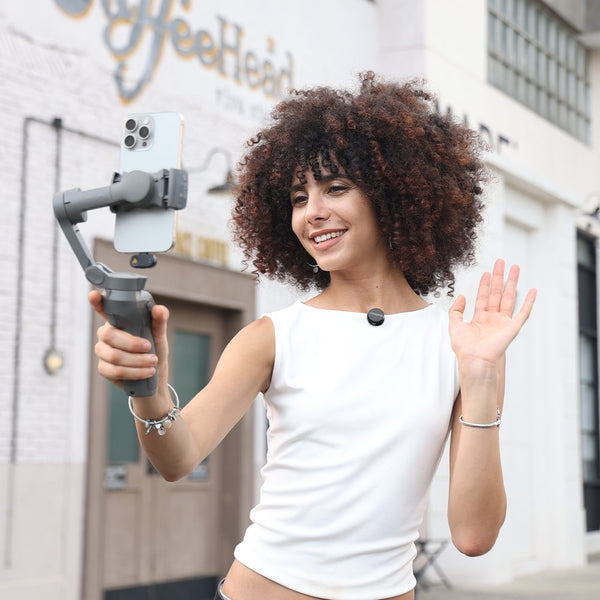We often hear the term "calorie deficit" or "caldef" on Facebook, TikTok, and even YouTube—especially when searching for the keyword "weight loss" on those platforms. Whether you're following fitness influencers or documenting your own journey with a wireless microphone, the concept of a calorie deficit is bound to come up. What exactly is a calorie deficit or a caldef?
Let's find out and explore why understanding a calorie deficit is so important.
Mastering Calorie Deficit: Weight Loss Tips, Tools & Vlogging Gear
In the world of health and fitness, the term "calorie deficit"—or “caldef”—has become a staple among those looking to lose weight--but what exactly is it?
A calorie deficit occurs when you consume fewer calories than your body needs to maintain its current weight. When in a deficit, your body taps into stored fat for energy, which leads to fat loss over time. Understanding and maintaining a proper calorie deficit is a foundational principle for effective and sustainable weight loss.
But the journey doesn’t stop at cutting calories. From knowing the right foods to eat, to calculating your needs accurately, and even tracking your progress through vlogging, mastering caldef can empower you to transform your health—and document it confidently.
Best Foods to Eat While Maintaining a Healthy Calorie Deficit
Eating fewer calories doesn’t mean eating less food—it means eating smarter. The best foods to support a healthy calorie deficit are:
-
High-protein foods: Chicken breast, Greek yogurt, eggs, cottage cheese, and tofu help preserve muscle and promote satiety.
-
High-fiber foods: Leafy greens, lentils, oats, berries, and cruciferous vegetables keep you fuller longer.
-
Low-calorie dense foods: Watermelon, cucumber, zucchini, popcorn (air-popped), and broth-based soups help you eat more volume with fewer calories.
-
Healthy fats in moderation: Avocados, nuts, seeds, and olive oil support overall health while providing satisfaction.
Combining these foods ensures you stay full, energized, and nourished while in a deficit.
How to Calculate Your Daily Calorie Deficit for Fat Loss
To lose weight effectively, you first need to calculate your maintenance calories—the number of calories your body needs to maintain its current weight. Use tools like the Mifflin-St Jeor Equation or online calculators to estimate this based on your age, weight, height, gender, and activity level.
Once you have your maintenance level, subtract 500–1000 calories per day to create a deficit. A 500-calorie daily deficit typically leads to about 1 pound of weight loss per week, while 1000 calories equals around 2 pounds per week—though this can vary based on metabolism and activity.
Top Apps and Tools to Track Calories and Stay in a Deficit
Using technology can make maintaining a calorie deficit much easier. Here are some of the top tools:
-
MyFitnessPal – A popular calorie and macro tracker with a large food database.
-
Lose It! – Offers barcode scanning, meal planning, and goal setting.
-
Chronometer – Great for detailed nutrient tracking and accuracy.
-
Yazio – Offers customized meal plans and calorie tracking.
-
Fitbit or Apple Watch – Tracks activity and calories burned to adjust your intake accordingly.
These apps help you monitor your intake, spot patterns, and make informed food decisions.
FAQ Section
How many calories should I eat per day to be in a deficit?
It depends on your maintenance level. A general guideline is to eat 500–1000 calories less than maintenance for fat loss.
How do I calculate my maintenance calories?
Use calculators that factor in age, weight, height, gender, and activity level—or track your food and weight for a couple of weeks to estimate manually.
Is it safe to be in a calorie deficit every day?
Yes, but only if it's a moderate deficit (e.g., 500 calories). Prolonged extreme deficits can lead to fatigue, nutrient deficiencies, or metabolic issues.
What are the best low-calorie, high-protein foods for fat loss?
Egg whites, tuna, chicken breast, Greek yogurt, protein shakes, lentils, and tofu.
Can I still eat carbs and stay in a calorie deficit?
Absolutely! Weight loss depends on calories in vs. calories out, not cutting carbs entirely.
What’s the difference between a 500-calorie and 1000-calorie deficit?
A 500-calorie deficit = ~1 lb fat loss/week.
A 1000-calorie deficit = ~2 lb fat loss/week (not always recommended long-term).
How do I know if I'm in a calorie deficit without counting every bite?
Track your weight weekly and notice trends. If weight is slowly decreasing, you’re likely in a deficit.
Can intermittent fasting help me stay in a calorie deficit more easily?
Yes. Fasting windows may help reduce total daily intake by limiting eating time.
Do I have to exercise to create a calorie deficit?
No, but exercise helps increase your calorie burn, making a deficit easier and more flexible.
What happens if I eat too little—can a deficit be too extreme?
Yes. Eating too little can slow metabolism, lead to muscle loss, fatigue, and poor health.
What foods help me stay full while eating fewer calories?
High-fiber veggies, lean proteins, whole grains, and foods with high water content (like soups or watermelon).
How do I avoid muscle loss while eating in a deficit?
Eat enough protein (1.6–2.2g/kg body weight) and do resistance training regularly.
What’s a realistic rate of weight loss on a calorie deficit?
Aim for 0.5–2 lbs per week. Anything faster could risk muscle loss or unsustainability.
How can I manage hunger and cravings in a calorie deficit?
Stay hydrated, eat fiber and protein, sleep well, and avoid ultra-processed snacks.
Are cheat meals okay while in a calorie deficit?
Yes, if planned wisely. Use them to satisfy cravings but keep total weekly calories in check.
What kitchen tools or gadgets help with portion control?
-
Digital food scale for accuracy
-
Measuring cups/spoons
-
Portion control containers
-
Blender or smoothie maker for healthy meals
Should I weigh my food to track calories accurately?
Yes, especially early on. It helps you understand portion sizes and track with precision.
Is it better to eat fewer meals or smaller portions throughout the day?
It depends on preference. Both can work if total daily intake stays within your deficit.
FAQ on Vlogging:
What tools can I use for recording my progress in a calorie deficit?
Documenting your journey can boost motivation. Use tools like:
-
Smartphone camera or mirrorless camera for visuals
-
Tripod or ring light for stable, well-lit shots
-
Fitness apps with shareable progress reports
-
Editing apps like CapCut, iMovie, or Adobe Premiere Rush
-
Choose wireless microphones or the best wireless Lavalier microphone for audio clarity
What wireless microphone is the best for vlogging my weight loss and calorie deficit progress?
For clear, professional audio while tracking your progress, consider the following: the Maono Wave T5 and the Maono Wave T1 Mini wireless microphones
For vlogging your weight loss progress clearly and confidently, the Maono Wave T5 Wireless Microphone stands out as an excellent choice.
Why Choose Maono Wave T5?

-
Crystal-clear audio
The dual-channel lavalier mic ensures your voice sounds sharp even in noisy environments.
-
Intelligent (AI) Noise Cancellation
Built-in tech actively filters out background noise—perfect for gym vlogs, walks, or kitchen cooking updates.
-
Long battery life
Up to 9 hours of recording per charge keeps you documenting all day without worry.
-
Plug-and-play
Comes with USB-C, Lightning, and 3.5mm adapters for seamless use with phones, tablets, or cameras.
-
Compact & stylish
Lightweight design with magnetic clip, making it nearly invisible in frame.
-
Pro Lavalier lapel microphone build quality with discreet magnetic clip.
Why it stands out: The Maono Wave T5 offers exceptional sound clarity with noise cancellation, making it ideal for both indoor and outdoor fitness content. Unlike many wireless mics, the Wave T5 is purpose-built for creators—especially fitness and health vloggers—offering professional-grade audio with zero fuss.
Whether you're using Android or iOS, the Wave T5 is the best wireless Lavalier microphone for iPhone and the best wireless Lavalier microphone for Android users alike. It’s built for creators who want pro-level Lavalier lapel microphone sound with portability.
Maono Wave T1 Mini Wireless Microphone

Features:
-
Lightweight and easy to clip on
-
Clip on Lavalier microphone design, lightweight and simple to use.
-
Plug-and-play setup, compatible with phones and tablets
-
Ideal for solo content creators
-
Clear, crisp audio capture
-
Affordable option for beginners
Why it stands out: The Maono Wave T1 Mini is budget-friendly and perfect for creators new to vlogging. Its simplicity, paired with excellent audio quality, makes it a standout pick.
Whether you're documenting daily meals, sharing workouts, or offering tips, the Wave T1 Mini is the best budget wireless Lavalier microphone for vloggers who want great sound without complexity.
Conclusion
Mastering a calorie deficit is both an art and a science. From selecting the right foods and tracking tools to understanding how your body works, weight loss becomes far more attainable when you equip yourself with knowledge and the right support.
Pair your fat-loss journey with vlogging to not only hold yourself accountable but also inspire others walking a similar path. With the right tools—like the Maono Wave T5 or T1 Mini, both strong contenders for the best wireless Lavalier microphone for iPhone and Android—you can ensure your voice is heard as clearly as your goals are seen.
Whether you're just starting out or refining your routine, remember: consistency and sustainability are key to long-term success. Your health journey deserves to be seen and heard—so grab your camera, attach your clip on Lavalier microphone, and start sharing your story today.
Related article:
Track Calories & Progress: Food Scale + Wireless Mic for Weight Loss



